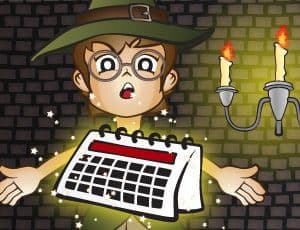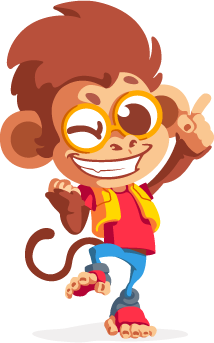Escola Games | Jogos Educativos
https://www.escolagames.com.br
Teacher's support sheet

Magic Calendar
Here we have a magic calendar we need to learn how to use to enjoy its powers. After answering all the questions, you can use the magic to go back in time and live a great adventure in the Dinosaurs Era.

Teacher's tips
Level of education: Elementary
Age: 06 to 09 years old
Subjects: Mathematics
Kids start changing their perception of time gradually, but teachers must give them opportunities to experience the social use of time.
Although kids are always in touch with many calendars, it is significant to broaden and systematize experiences so that they can make sense of their use. This approach allows them to work with quantities and measures related to time, such as days, months, and years. Moreover, It is an excellent source of information and research for reading and recording numbers. [FIM-DICA]
Learner outcomes
To recognize the calendar (day, month, and year) as a fundamental part of our daily lives;
To relate and identify the units of measurements of time - day, week, month, and year;
To learn about how numbers work in the specific context of calendars;
To build the notion of counting and sequencing days of the week, highlighting the sequence and time duration;
To establish a relation between the events of today, yesterday, and tomorrow;
To comprehend and relate the units of time measurement to the social context;
To recognize the meaning of quarters, semesters, and leap years;
To understand the time organization: days, months, years, decades, and centuries;
To learn about different calendars;
To experience challenges to solve problems involving days, months, and years.
Teachers' goals
To teach students about the sequence and duration of time by counting and sequencing days, weeks, months, and years;
To propose they use the numbers in different contexts;
To offer the game as a didactic resource to explore the content discussed in the classroom;
To present students with different ways of measuring time;
To show students the importance of the calendar.
Suggestions of approaches for the teacher
(Approach 1) You can organize the class in groups and stimulate them to share their ideas to find the correct answer. On the final challenge, they must take turns to play.
(Approach 2) Help them identify the composition of a calendar: words, numbers, and columns. Separate the columns and lines by colors to help them.
(Approach 3) Put a calendar on the wall so students can check on it daily. You can put one of a month or one that has all the months on it.
(Approach 4) It is vital to create a routine to ask them at the beginning of the class: what day is today? What day of the week is today? Which is the month?
Gradually, ask them more questions as a way to explore the calendar:
What day of the month was it yesterday? And what day of the week was yesterday?
Which day will be tomorrow?
How many days until the end of the month?
Which is the last day of the week of this month?
Tomorrow will be a new month, which is its name?
How many days until Halloween?
(Approach 5) It is relevant to mark on the calendar dates students consider important, such as school events and birthdays.
You can propose different situations related to the game:
Which other month has the same number of days as this one?
What was the first day of this month?
Look at the last day of this month. Which will be the first day of next month? Which is the month?
If we are on the 4th Wednesday of the month, which day is today?
There are 48 hours left for Saturday. How many days until Saturday?
There is a school event on the 30th. How many days until there?
Laura's birthday is on the 5th day of the month. Samuel's birthday is 18 days after Laura's. What day is Samuel's birthday?
How many weeks are there this month?
How many school days are there this month?
Observe the month on the game and write the ones that come after it.
(Approach 6) You can organize a book club and ask students to read a book that talks about time. "It's About Time: Untangling Everything You Need to Know About Time" by Pascale Estellon is a suggestion.
(Approach 7) Elaborate a calendar with students with their birthdays. Then, remind them to keep an eye on it so they do not miss any birthdays.
(Approach 8) Present to students different calendars of humanity's history (the Gregorian, the Maya, and the Islamic calendars.)
(Approach 9) Create an hourglass with students.
(Approach 10) Elaborate a fun calendar in which students have to mark special events, such as Easter and Christmas.
More about the content
Learn about some calendars throughout history
A solar calendar is any dating system based on the seasonal year of approximately 365 1/4 days, the time it takes the Earth to revolve once around the Sun. The Egyptians appear to have been the first to develop a solar calendar, using as a fixed point the annual sunrise reappearance of the Dog Star—Sirius, or Sothis—in the eastern sky, which coincided with the annual flooding of the Nile River. They constructed a calendar of 365 days, consisting of 12 months of 30 days each, with five days added at the year's end. The Egyptians' failure to account for the extra fraction of a day, however, caused their calendar to drift gradually into error. https://www.britannica.com/science/solar-calendar
The Gregorian calendar, also called the New Style calendar, is a solar dating system now in general use. It was proclaimed in 1582 by Pope Gregory XIII as a reform of the Julian calendar. By the Julian reckoning, the solar year comprised 365 1/4 days, and the intercalation of a “leap day” every four years was intended to maintain correspondence between the calendar and the seasons. A slight inaccuracy in the measurement (the solar year comprising more precisely 365 days, 5 hours, 48 minutes, 45.25 seconds) caused the calendar dates of the seasons to regress almost one day per century.
https://www.britannica.com/topic/Gregorian-calendar
Of all the ancient calendar systems, the Maya and other Mesoamerican systems are the most complex and intricate. They used 20-day months and had two calendar years: the 260-day Sacred Round, or tzolkin, and the 365-day Vague Year, or haab. These two calendars coincide every 52 years. The 52-year period of time was called a "bundle" and meant the same to the Maya as our century does to us.
The Chinese calendar is lunisolar. It is based on exact astronomical observations of the Sun's longitude and the Moon's phases. It attempts to have its years coincide with the tropical year and shares some similarities with the Jewish calendar. In both these calendars, a common year has 12 months, a leap year has 13 months; an ordinary year has 353–355 days, and a leap year has 383–385 days.
https://www.timeanddate.com/calendar/about-chinese.html
The Islamic Calendar begins its counting from the year 622 A.D. This marks the year of the Prophet's migration, or hijra, which gives the calendar its official name. The calendar was created in 638 D.C., during the reign of Khalifa Umar ibn al-Khattab. He created this calendar to adjust the counting of the time and days for some Islamic religious observances. The chronology of the Islamic Calendar is based on some excerpts from the Quran.
https://www.calendarr.com/united-states/the-islamic-calendar/
